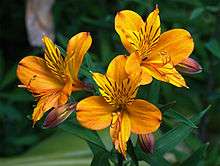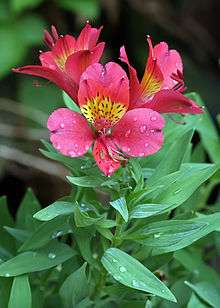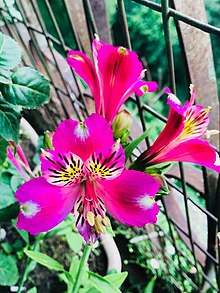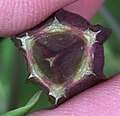Alstroemeria
Alstroemeria (/ˌælstrɪˈmɪəriə/), commonly called the Peruvian lily or lily of the Incas, is a genus of flowering plants in the family Alstroemeriaceae. They are all native to South America although some have become naturalized in the United States, Mexico, Australia, New Zealand, Madeira and the Canary Islands. Almost all of the species are restricted to one of two distinct centers of diversity, one in central Chile, the other in eastern Brazil. Species of Alstroemeria from Chile are winter-growing plants while those of Brazil are summer-growing. All are long-lived perennials except A. graminea, a diminutive annual from the Atacama Desert of Chile.
| Alstroemeria | |
|---|---|
 | |
| Peruvian lily (Alstroemeria aurea) | |
| Scientific classification | |
| Kingdom: | Plantae |
| Clade: | Tracheophytes |
| Clade: | Angiosperms |
| Clade: | Monocots |
| Order: | Liliales |
| Family: | Alstroemeriaceae |
| Genus: | Alstroemeria L. |
| Type species | |
| Alstroemeria pelegrina | |
| Synonyms[1] | |
| |



Description
Plants of this genus grow from a cluster of tubers. They send up fertile and sterile stems, the fertile stems of some species reaching 1.5 meters in height. The leaves are alternately arranged and resupinate, twisted on the petioles so that the undersides face up. The leaves are variable in shape and the blades have smooth edges. The flowers are solitary or borne in umbels. The flower has six tepals each up to 5 centimeters long. They come in many shades of red, orange, purple, green, and white, flecked and striped and streaked with darker colors. There are six curving stamens. The stigma has three lobes. The fruit is a capsule with three valves. Alstroemeria are classified as an inferior monocot, meaning the petals are located above the ovary and the leaves are parallel.[2]
 An Alstroemeria cultivar
An Alstroemeria cultivar Alstroemeria capsule viewed from above, showing anatomical detail, including apical beak, vascular bundles (in section) in ribs etc.
Alstroemeria capsule viewed from above, showing anatomical detail, including apical beak, vascular bundles (in section) in ribs etc. Alstroemeria seed capsule viewed from side, showing winged ribs and (triangular pyramidal) apical beak.
Alstroemeria seed capsule viewed from side, showing winged ribs and (triangular pyramidal) apical beak. Premature dehiscence of Alstroemeria seed capsule
Premature dehiscence of Alstroemeria seed capsule
Taxonomy
The genus was described by Johan Peter Falk and his thesis supervisor Carl Linnaeus in his 1762 dissertation Planta Alströmeria.[3] Linnaeus bears the botanical authority (L.).
Etymology
The genus was named after the Swedish baron Clas Alströmer (1736–1794), a friend of Linnaeus.
Cultivation and uses
Many hybrids and at least 190 cultivars have been developed, featuring many different markings and colors, including white, yellow, orange, apricot, pink, red, purple, and lavender. The most popular and showy hybrids commonly grown today result from crosses between species from Chile (winter-growing) with species from Brazil (summer-growing). This strategy has overcome the florists' problem of seasonal dormancy and resulted in plants that are evergreen, or nearly so, and flower for most of the year. This breeding work derives mainly from trials that began in the United States in the 1980s, the main breeding is done nowadays by companies in the Netherlands. The flower, which resembles a miniature lily, is very popular for bouquets and flower arrangements in the commercial cut flower trade. These delicate flowers survive up to 14 days in water without any signs of shrivelling.[4]
Most cultivars available for the home garden will bloom in the late spring and early summer. The roots are hardy to a temperature of 23 °F (−5 °C). The plant requires at least six hours of morning sunlight, regular water, and well-drained soil.
AGM cultivars
The following cultivars have gained the Royal Horticultural Society's Award of Garden Merit, all with a hardiness rating of H4 (Hardy – average winter -10°C to -5°C) apart from 'Friendship' (H5: Hardy – cold winter -15°C to -10°C):
- 'Apollo'[5] (white/yellow flowers)
- 'Cahors'[6] (pink/yellow)
- 'Coronet'[7] (salmon/yellow flowers)
- 'Friendship'[8] (yellow flushed pink)
- 'Orange Glory'[9]
- 'Oriana'[10] (salmon/yellow)
- 'Phoenix'[11] (red/yellow)
- 'Red Elf'[12]
- 'Sirius'[13] (pink/yellow)
- 'Sonata'[14] (red/yellow)
- 'Spitfire'[15] (orange/yellow)
- 'Tessa'[16] (red flowers)
- 'Yellow Friendship'[17]
Ecology
Some alstroemerias have escaped cultivation and become weeds, such as Alstroemeria pulchella. and A. aurea, which are now weeds in Australia.
Species
| Image | Name | Distribution |
|---|---|---|
| Alstroemeria achirae | Maule | |
| Alstroemeria albescens | Rio Grande do Sul | |
| Alstroemeria altoparadisea | Goiás | |
| Alstroemeria amabilis | Brazil | |
| Alstroemeria amazonica | Pará, Bolívar | |
| Alstroemeria andina | Chile, Argentina | |
.jpg) | Alstroemeria angustifolia | Chile |
| Alstroemeria annapolina | Goiás | |
| Alstroemeria apertiflora | Brazil, Argentina, Paraguay | |
| Alstroemeria aquidauanica | Mato Grosso | |
| Alstroemeria arnicana | Goiás | |
| Alstroemeria aulica | Valparaíso | |
 | Alstroemeria aurea | Chile, Argentina; naturalized in New Zealand, Victoria (Australia) |
| Alstroemeria bahiensis | Bahia | |
| Alstroemeria bakeri | Catamarca | |
| Alstroemeria bilabiata | Santiago de Chile | |
.jpg) | Alstroemeria brasiliensis | Brazil |
| Alstroemeria burchellii | Goiás | |
| Alstroemeria cabralensis | Minas Gerais | |
| Alstroemeria caiaponica | Goiás | |
| Alstroemeria calliantha | Minas Gerais | |
| Alstroemeria cantillanica | O'Higgins | |
| Alstroemeria capixaba | Espírito Santo | |
| Alstroemeria caryophyllaea | Brazil | |
| Alstroemeria chapadensis | Mato Grosso | |
| Alstroemeria chorillensis | Peru | |
| Alstroemeria crispata | northern Chile | |
| Alstroemeria cuiabana | Mato Grosso | |
| Alstroemeria cultrifolia | Brasília | |
| Alstroemeria cunha | Brazil | |
| Alstroemeria decora | Valparaíso | |
.jpg) | Alstroemeria diluta | Chile |
| Alstroemeria discolor | Valparaíso | |
| Alstroemeria douradensis | Goiás | |
| Alstroemeria espigonensis | Bahia | |
.jpg) | Alstroemeria exserens | Chile, Argentina |
| Alstroemeria fiebrigiana | Bolivia | |
| Alstroemeria firmulifolia | Minas Gerais | |
| Alstroemeria foliosa | Brazil, Paraguay | |
| Alstroemeria fuscovinosa | Brazil | |
 | Alstroemeria garaventae | Chile |
| Alstroemeria gardneri | Brazil | |
| Alstroemeria glaucandra | Valparaíso | |
| Alstroemeria gouveiana | Minas Gerais | |
| Alstroemeria graminea | Chile | |
 | Alstroemeria hookeri | Chile |
| Alstroemeria huemulina | Bío Bío | |
| Alstroemeria ibitipocae | Minas Gerais | |
| Alstroemeria igarapavica | São Paulo | |
| Alstroemeria inodora | Brazil | |
| Alstroemeria isabellana | Brazil, Argentina, Uruguay, Paraguay | |
| Alstroemeria itabiritensis | Minas Gerais | |
| Alstroemeria jequitiana | Minas Gerais | |
| Alstroemeria jocunda | Santiago de Chile | |
| Alstroemeria julieae | Minas Gerais | |
.jpg) | Alstroemeria kingii | Chile |
| Alstroemeria lactilutea | Tarapacá | |
| Alstroemeria landimana | Brasília | |
.jpg) | Alstroemeria leporina | Chile |
.jpg) | Alstroemeria ligtu, St. Martin's flower | Peru, Chile, Argentina |
| Alstroemeria litterata | Mato Grosso | |
| Alstroemeria longaviensis | Maule | |
| Alstroemeria longistaminea | Brazil | |
| Alstroemeria longistyla | Goiás, Minas Gerais | |
| Alstroemeria lutea | Tarapacá | |
| Alstroemeria magna | Valparaíso | |
 | Alstroemeria magnifica | Chile |
| Alstroemeria malmeana | Brazil | |
| Alstroemeria modesta | Chile | |
| Alstroemeria mollensis | Coquimbo | |
| Alstroemeria monantha | Chile | |
| Alstroemeria monticola | Bahia, Minas Gerais | |
| Alstroemeria nidularis | Maule | |
| Alstroemeria nivea | Coquimbo | |
| Alstroemeria ochracea | Minas Gerais | |
| Alstroemeria orchidioides | Brasília, Goiás | |
| Alstroemeria pallida | Chile | |
| Alstroemeria paraensis | Pará | |
| Alstroemeria patagonica | southern Argentina, southern Chile | |
| Alstroemeria paupercula | Peru, northern Chile | |
| Alstroemeria pelegrina, Peruvian lily | Peru, Chile | |
| Alstroemeria penduliflora | Minas Gerais | |
| Alstroemeria philippii | northern Chile | |
| Alstroemeria piauhyensis | Brazil | |
 | Alstroemeria plantaginea | Brazil, Venezuela |
| Alstroemeria poetica | Chile | |
| Alstroemeria polpaicana | Santiago | |
| Alstroemeria polyphylla | Chile | |
| Alstroemeria presliana | Chile, Argentina | |
| Alstroemeria pseudospathulata | Chile, Argentina | |
| Alstroemeria psittacina | Brazil, Argentina | |
| Alstroemeria pubiflora | Goiás | |
| Alstroemeria pudica | Santiago | |
.jpg) | Alstroemeria pulchella, New Zealand Christmas-bell | Brazil, Argentina; naturalized in Australia, New Zealand, Southeastern United States, southern Mexico, Madeira, Canary Islands |
| Alstroemeria pulchra | Chile | |
| Alstroemeria punctata | Brasília, Goiás | |
| Alstroemeria pygmaea | Peru, Brazil, Argentina | |
| Alstroemeria radula | Brazil | |
| Alstroemeria recumbens | Chile | |
.jpg) | Alstroemeria revoluta | Chile |
| Alstroemeria ribeirensis | Paraná | |
| Alstroemeria roseoviridis | Mato Grosso do Sul | |
| Alstroemeria rupestris | Minas Gerais | |
| Alstroemeria sabulosa | Valparaíso | |
| Alstroemeria schizanthoides | Chile | |
| Alstroemeria sellowiana | Brazil | |
.jpg) | Alstroemeria spathulata | Chile, Argentina |
| Alstroemeria speciosa | São Paulo | |
| Alstroemeria spectabilis | Santiago | |
 | Alstroemeria stenopetala | Goiás, Minas Gerais |
| Alstroemeria talcaensis | Maule | |
| Alstroemeria timida | Santiago | |
| Alstroemeria tombolatoana | Goiás, Minas Gerais | |
.jpg) | Alstroemeria umbellata | Chile, Argentina |
| Alstroemeria variegata | Minas Gerais | |
| Alstroemeria venusta | Chile | |
.jpg) | Alstroemeria versicolor | Chile |
| Alstroemeria virginalis | Coquimbo | |
| Alstroemeria viridiflora | Brazil | |
| Alstroemeria werdermannii | Chile | |
| Alstroemeria xavantinensis | Mato Grosso | |
| Alstroemeria yaelae | Santiago | |
| Alstroemeria zoelneri | Chile | |
Citations
- Kew World Checklist of Selected Plant Families
- Alstroemeria. Flora of North America.
- Linnaeus & Falk 1762.
- Long Lasting Flowers
- "RHS Plant Selector Alstroemeria 'Apollo' AGM / RHS Gardening". Apps.rhs.org.uk. Retrieved 5 April 2020.
- "Alstroemeria 'Cahors'". Royal Horticultural Society. Retrieved 5 January 2018.
- "RHS Plant Selector Alstroemeria 'Coronet' AGM / RHS Gardening". Apps.rhs.org.uk. Retrieved 5 April 2020.
- "RHS Plant Selector Alstroemeria 'Friendship' AGM / RHS Gardening". Apps.rhs.org.uk. Retrieved 2013-04-30.
- "RHS Plant Selector Alstroemeria 'Orange Glory' AGM / RHS Gardening". Apps.rhs.org.uk. Retrieved 5 April 2020.
- "Alstroemeria 'Oriana'". Royal Horticultural Society. Retrieved 5 January 2018.
- "Alstroemeria 'Phoenix'". Royal Horticultural Society. Retrieved 5 January 2018.
- "Alstroemeria 'Red Elf'". Royal Horticultural Society. Retrieved 5 January 2018.
- "Alstroemeria 'Sirius'". Royal Horticultural Society. Retrieved 5 January 2018.
- "Alstroemeria 'Sonata'". Royal Horticultural Society. Retrieved 5 January 2018.
- "Alstroemeria 'Spitfire'". Royal Horticultural Society. Retrieved 5 January 2018.
- "Alstroemeria 'Tessa'". Royal Horticultural Society. Retrieved 5 January 2018.
- "RHS Plant Selector Alstroemeria 'Yellow Friendship' AGM / RHS Gardening". Apps.rhs.org.uk. Retrieved 5 April 2020.
General sources
- Linnaeus; Falk, Johan Peter (1762). Planta Alströmeria. Holmiae: Laurentii Salvii.CS1 maint: ref=harv (link), published in Amoenitates Academicae 6: 247–262 1763
- Sanso, Andrea Mariel (1996). "EL GÉNERO ALSTROEMERIA (ALSTROEMERIACEAE) EN ARGENTINA". Darwiniana. 34 (1/4): 349–382. JSTOR 23223205.CS1 maint: ref=harv (link)
External links
| Wikispecies has information related to Alstroemeria |
| Wikimedia Commons has media related to Alstroemeria. |